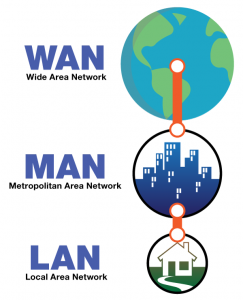6.3. Networks
Today most businesses use networks to deliver information to employees, suppliers, and customers. A computer network is a group of two or more computer systems linked together by communications channels to share data and information. Networks often link thousands of users and can transmit audio and video as well as data.
Networks include clients and servers. The client is the application that runs on a personal computer or workstation. It relies on a server that manages network resources or performs special tasks such as storing files, managing one or more printers, or processing database queries. Any user on the network can access the server’s capabilities.
By making it easy and fast to share information, networks have created new ways to work and increase productivity. They provide more efficient use of resources, permitting communication and collaboration across distance and time. With file-sharing, all employees, regardless of location, have access to the same information. Shared databases also eliminate duplication of effort. Employees at different sites can “screen-share” computer files, working on data as if they were in the same room. Their computers are connected by phone or cable lines, they all see the same thing on their display, and anyone can make changes that are seen by the other participants. The employees can also use the networks for videoconferencing.

Networks also make it possible for companies to run enterprise software, large programs with integrated modules that manage all of the corporation’s internal operations. We will discuss enterprise systems more in Chapter 11.
Connecting Near and Far

There are three types of networks distinguished by the area they cover: local area networks, wide area networks and metropolitan area networks. A local area network (LAN) lets people at one site exchange data and share the use of hardware and software. LANs offer companies a more cost-effective way to link computers than linking terminals to a mainframe computer. The most common uses of LANs at small businesses, for example, are office automation, accounting, and information management. LANs can be set up with wired or wireless connections.
A Metropolitan area network (MAN) spans a larger area like a city or region whereas a wide area network (WAN) connects computers at different sites via telecommunications media such as phone lines, satellites, and microwaves. A modem connects the computer or a terminal to the telephone line and transmits data almost instantly, in less than a second. Telecommunications companies, such as Rogers Communications, Bell Canada, or Telus Inc., operate very large WANs. The internet is essentially a worldwide WAN.
“13.2 Linking Up Computer Networks” from Introduction to Business by OpenStax-Rice University is licensed under Creative Commons Attribution 4.0 License

